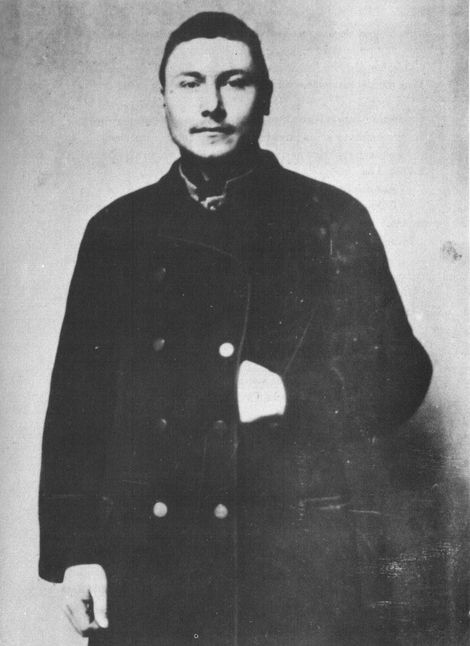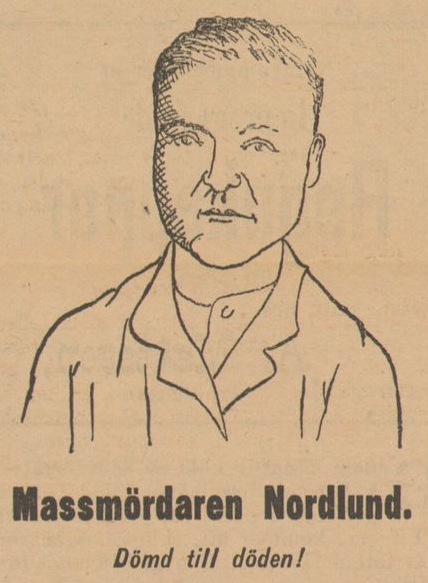
1875 - 1900
John Filip Nordlund
Summary
Name:
Nickname:
Mälarmördaren / Mordlund / Svarte FilipYears Active:
1900Birth:
March 23, 1875Status:
ExecutedClass:
Mass MurdererVictims:
5Method:
Shooting / StabbingDeath:
December 10, 1900Nationality:
Sweden
1875 - 1900
John Filip Nordlund
Summary: Mass Murderer
Name:
John Filip NordlundNickname:
Mälarmördaren / Mordlund / Svarte FilipStatus:
ExecutedVictims:
5Method:
Shooting / StabbingNationality:
SwedenBirth:
March 23, 1875Death:
December 10, 1900Years Active:
1900bio
John Filip Nordlund was born on March 23, 1875, in Övre Stubbersbo, near Säter, which is located outside Falun, Sweden. He was the middle child in his family, having an older brother named Joel, who was deaf and mute, and a younger brother named Rickard. As a child, Nordlund was seen as odd and reportedly never laughed.
In 1882, the Nordlund family moved to Falun. John attended school there but did not finish because he was impatient and restless. By 1886, he left home and traveled with a classmate who was an orphan. Later that same year, a family friend found him in Hedemora and brought him back home. However, he ran away again in 1887. He was a large and strong boy, which allowed him to work and pass as an adult.
For a brief period of one and a half years, Nordlund worked at a lumber mill in Korsnäs. He claimed this was the only time he truly tried to lead an honest life. However, he eventually succumbed to temptation and forged a bill, which led to his dismissal from the mill. After this, his parents moved to Gävle, and he also lived there for a short time.
During his travels, Nordlund became accustomed to stealing. In 1891, he was arrested for cattle rustling and sentenced to four months in prison by a court in Ljusdal. Later that same year, he faced a longer prison sentence of three years for theft. This time, he served his time at the county jail in Malmö. In 1895, he was sentenced to another three years and was enrolled as prisoner number two at Långholmen Prison in Stockholm. His unruly behavior while incarcerated resulted in an extended sentence of four years. By 1900, he had started to develop plans for his future, which he later mentioned in letters he wrote from prison.
On April 20, 1900, Nordlund was released from Långholmen Prison. With help from his younger brother, who was living in Stockholm and working as a clerk, he returned to Gävle. As an ex-convict, he found it challenging to secure a job. Soon, he went back to a life of crime, which led him to devise a drastic plan for one last big theft.
murder story
On the night of 16 and 17 May 1900, John Filip Nordlund executed a violent plan on the ferry called Prins Carl, which traveled from Arboga to Stockholm. He had packed two revolvers, several knives, and padlocks in his luggage. Nordlund aimed to rob and kill as many passengers as he could. He also intended to burn the ship to cover his tracks. However, he was soon discovered when frightened passengers alerted another ferry, the Köping. Despite this, Nordlund still killed four people and injured nine others during the chaos. The victims included the ship's captain, a butcher, an elderly woman, a farmer, and a cattle merchant. He managed to get away from the ferry in a lifeboat because people underestimated his strength.
The next day, he was arrested at a train station in Skogstorp, near Eskilstuna. He had planned to travel to Copenhagen after changing his clothes. When police detained him, he shouted about revenge and expressed that he would have killed more if he had escaped. After his arrest, Nordlund was placed in a cell where an angry mob nearly attacked him. On 18 May, he wrote a letter to his family admitting to the crimes. He explained that he felt detached from society and seemed to expect execution as his fate. He did not show remorse during his trial and even stated he regretted not killing everyone on the ferry. He was found guilty of five murders and eight attempted murders, and he was sentenced to death.

While waiting for his execution, he attempted to escape from jail twice, injuring guards in the process. Many newspapers published sensational stories about him, sometimes exaggerating details of the crimes. Nordlund was not interested in appealing for mercy from the king but did complain to the Supreme Court about his robbery charge. The court rejected his complaint. In his final days, he met with his mother and was visited by a priest.
On 10 December 1900, Nordlund was executed by beheading at Västerås County Jail. The execution was fast, with the high executioner using a large blade. His actions and the public response to them sparked intense debates about the need for capital punishment in Sweden. His case was often cited by both supporters and opponents of the death penalty in the years that followed.